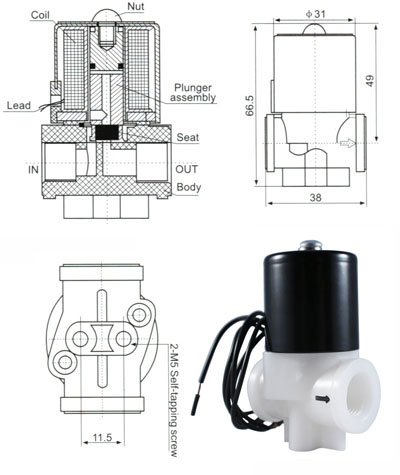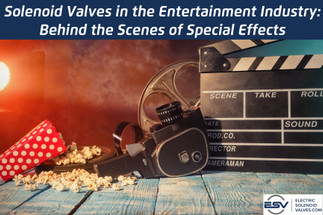Apr 8th 2024
Solenoid Valves in the Entertainment Industry: Behind the Scenes of Special Effects
Behind many of the special effects in your favorite movies, TV shows, and live performances, there is a solenoid valve making the magic happen. These small devices are used in a wide range of special effects, from pyrotechnics and fog machines to animatronics and water features. Their precise control ability to quickly open and close make them an invaluable tool for entertainment producers.
How Do Solenoid Valves Work?
 Solenoid valves are electromechanically operated valves that control the flow of fluids or gases. They are simple yet effective devices that consist of solenoid coil, a plunger, and a valve seat. When an electrical current passes through the solenoid's coil, it creates a magnetic field that opens or closes the valve by pulling the plunger up or down. When the current is turned off, the plunger goes back to its original position, opening or closing the valve.
Solenoid valves are electromechanically operated valves that control the flow of fluids or gases. They are simple yet effective devices that consist of solenoid coil, a plunger, and a valve seat. When an electrical current passes through the solenoid's coil, it creates a magnetic field that opens or closes the valve by pulling the plunger up or down. When the current is turned off, the plunger goes back to its original position, opening or closing the valve.
Read more here - How a 2-Way Solenoid Valve Works
Why Solenoid Valves are Perfect for Special Effects
Reliability:
The stakes are always high for film effects and live events, so it is important to do everything possible to guarantee flawless execution of the effects. Solenoid valves’ simple, reliable construction is prized for its dependable performance. They're the backbone of productions that make sure effects go off without a hitch, every single time.
Precision Timing:
Solenoid valves are fast. They allow the operators to have split-second control over the start, duration, and even intensity of effects. These valves can be used to unleash a burst of fog, trigger a fountain jet, or activate a prop at the exact moment needed. They offer both on/off operation and the ability to regulate flow for everything from a gentle mist to a powerful blast.
Repeatability:
If a scene needs to be shot multiple times or a show runs nightly, solenoid valves are the ideal choice. These effects need to look and act the same every time the director says action, the curtain rises, or the ride resets. Solenoid valves ensure that the effects can be replicated flawlessly each time.
Remote Control:
The ability to operate solenoid valves from a distance or through automated systems enhances safety, precision, and efficiency in these entertainment processes. Remote controls can be set up through systems to automate the valves to provide precise and coordinated effects, whether it is for just one valve or a system of multiple valves for more complex and dynamic effects.
Variety of Materials:
Solenoid valves can be integrated in a wide variety of systems to control many different types of media. They can be used to control the flow of water, fog, air, and certain fuels. This makes them useful for diverse effects like water curtains, fog machines, air cannons, and even flame effects. Their versatility can be used to create a wide range of effects, from subtle to dramatic, with precision and control. Valves are made of different materials like brass, stainless steel, and different types of plastic. Each of these have their own chemical compatibility that effects producers use for specific tasks.
Real World Examples of SVs in the Entertainment Industry
The number of ways solenoid valves are used in creating entertainment effects is countless. Below are just a few types of effects you’ll often see where solenoid valves aid in creating captivating and immersive experiences:
Movie Magic - TV/Film
Rain/Water Effects:
Solenoid valves precisely control sprinklers and water jets, creating rain downpours, suspenseful individually timed water "drops", or water explosions.
Blood Splatter:
Used to precisely release fake blood for gory special effects like blood spurts from knife wounds and squib shots.
Fog Machines:
Controls the release of fog fluid or hot vapor with steam solenoid valves, generating eerie mist, smoky environments, and sudden appearances of ghosts or spirits.
Explosive Effects:
Creates safe and precise control over flames in films and tv. Smaller solenoid valves are often used to trigger pyrotechnics for simulated explosions on miniature sets.
Creature Effects:
Animatronics engineers use pneumatic solenoid valves to control the movement of eyes, mouths, or limbs in realistic creature models.
Stagecraft Illusions - Live Plays
Prop Control:
Activating concealed stage elements, such as the unexpected opening of a trapdoor or controlling the rapid assembly or disassembly of set pieces.
Falling Objects:
Normally closed solenoids make sure special moments like the release of confetti or glittery magic happen at the precise time.
Scenic Automation:
Small solenoid valves might be integrated into set pieces to create subtly to massive shifting scenery like a poster changing images to the collapse of a structure.
Engineered Showmanship - Live Performances
Flame Effects:
Low pressure gas solenoid valves control gas flow to create bursts of flame for concerts or dramatic stage effects.
Bubble Machines:
Used to regulate the creation and release of bubbles for whimsical effects and creating the illusion of an underwater scene.
Water Curtains:
Creating mesmerizing water curtains with precisely timed releases of water that can be used for projecting screens or simulating a storm.
Immersive Thrills - Theme Parks
Water Spritzers:
Often found on rides where normally open valves release bursts of water to surprise or cool down riders.
Geysers/Fountains:
Solenoids create water features with timed jets and dynamic displays.
Animatronics:
Small pneumatic solenoid valves control the detailed movements of animatronic figures on park rides or dancing animatronic animals in places like the Tiki Room in Disney World, to make them come "alive".
Triggered Surprises:
Hidden solenoid valves can control sudden air blasts, popping props, or other unexpected effects.
Interactive Experiences
Haunted Houses:
Solenoids are perfect for triggering creepy effects like slamming doors, moving objects, or using mist to create the feeling of a quick temperature drop.
Escape Rooms:
Used to control hidden mechanisms like locks that open when a clue is solved or timed events for a more engaging experience.
Art Installations:
Solenoid valves are sometimes used for unique art installations that do things like creating an interactive water fountain or moving objects on a kinetic structure.
Conclusion
When entertainers want to really wow their audiences, solenoid valves are often hidden behind the scenes. From pyrotechnics and fog machines to animatronics and water features, solenoid valves play a vital role in bringing the magic of the entertainment world to life.
Take Your Special Effects to the Next Level - Browse Our Solenoid Valve Lineup.

